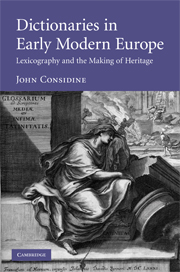Book contents
- Frontmatter
- Dedication
- Contents
- Acknowledgements
- Conventions and abbreviations
- Chapter 1 Introduction
- Chapter 2 The classical heritage I: Philology and lexicography
- Chapter 3 The classical heritage II: Henri Estienne and his world
- Chapter 4 Vernacular heritages I: Germany and the Netherlands 1500–1618
- Chapter 5 Vernacular heritages II: England to circa 1650
- Chapter 6 Vernacular heritages III: England and Scandinavia, circa 1650–1675
- Chapter 7 Post-classical heritages: Du Cange and his world
- Chapter 8 Shared heritages: Polyglot and universal dictionaries
- Conclusion
- Afterword
- Bibliography
- Index
Chapter 2 - The classical heritage I: Philology and lexicography
Published online by Cambridge University Press: 22 September 2009
- Frontmatter
- Dedication
- Contents
- Acknowledgements
- Conventions and abbreviations
- Chapter 1 Introduction
- Chapter 2 The classical heritage I: Philology and lexicography
- Chapter 3 The classical heritage II: Henri Estienne and his world
- Chapter 4 Vernacular heritages I: Germany and the Netherlands 1500–1618
- Chapter 5 Vernacular heritages II: England to circa 1650
- Chapter 6 Vernacular heritages III: England and Scandinavia, circa 1650–1675
- Chapter 7 Post-classical heritages: Du Cange and his world
- Chapter 8 Shared heritages: Polyglot and universal dictionaries
- Conclusion
- Afterword
- Bibliography
- Index
Summary
The labours of Hercules: Lexicography and the classical heritage at the time of Erasmus
A literary canon is defined in order to embody a cultural heritage. When the philologists of Hellenistic Alexandria made lists of the authors whose writings merited particular attention, they were selecting a heritage, saying that these authors were connected with their own period, and encouraging the reinforcement of that connection by imitation. The theme of the imitation of selected ancients – the classici as they were called as early as the second century ad – has a long history, from Statius’ closing of his epic Thebais with the injunction to the poem to follow the footsteps of Virgil’s Aeneid and worship them at a respectful distance, through Chaucer’s injunction to his poem Troilus and Criseyde to ‘kis the steppes, wheras thou seest pace Virgile, Ovyde, Omer, Lucan and Stace’. There has been a classical heritage for as long as there has been a canon of classical authors in whose footsteps a reader might try to follow.
In the fourteenth and fifteenth centuries, the canon that had been known and available in ancient Rome was known no longer to be fully available, and earnest efforts to recover it were being made: this is the familiar story of the textual rediscoveries of the Renaissance.
- Type
- Chapter
- Information
- Dictionaries in Early Modern EuropeLexicography and the Making of Heritage, pp. 19 - 55Publisher: Cambridge University PressPrint publication year: 2008



